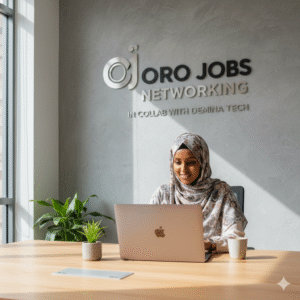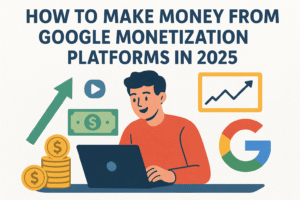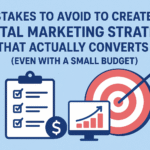Hey friends! If you’ve ever wondered how to actually make money from the various ways Google lets you monetize online—whether via your website, blog, app, or even videos—this post is for you. Grab a cup of coffee (or tea), settle in, and let’s explore the landscape for 2025 together. Google Monetization Platforms
We’ll go deep—strategies, best practices, mistakes to avoid, what Google expects, and how you can build something sustainable. By the end, I hope you’ll feel equipped to pick the right Google monetization platform for you, and start turning value into income.
Why Google Monetization Platforms Are Still a Big Deal
Google has long been a dominant player in the ad/monetization space. Whether you think of it as “ads on websites,” “in-apps,” or “videos,” Google has platforms doing the heavy lifting. Two key reasons why they still matter:
- Scale & reach – Google runs one of the largest ad networks in the world; smaller publishers/app creators get access to advertiser demand they couldn’t build on their own.
For example, the Google AdMob platform mentions that it can help your app serve ads to users in more than 200 countries. AdMob+1 - Continuous innovation – In 2025, for instance, Google has announced new AI-powered tools for publishers of their ad-platforms to help automate manual work, improve ad quality, and better monetise live moments. blog.google
So, if you’re thinking of monetising in 2025 (and beyond), ignoring Google’s monetisation platforms is probably a mistake. But—there’s a “but”—you must play by the evolving rules and optimise smartly.
What “Google Monetization Platforms” Really Mean
When I say “Google monetization platforms,” I’m referring to the set of tools/services Google offers to publishers (people who create content: websites, blogs, apps, video channels) so they can make money through advertising, subscribers, in-apps, etc. The main ones you’ll want to know:
- Google AdSense: Website/blog content monetisation using Google ads. Google AdSense+2Wikipedia+2
- Google Ad Manager: More advanced ad management for publishers with higher traffic or direct advertising relationships. Wikipedia+1
- Google AdMob: Monetisation for mobile apps (and other in-app products) via ads. AdMob
- There are also others in Google’s ecosystem (subscriptions, in-app purchases, etc.), but for many creators publishers these three are central.
In short—you create content (in whatever shape), you put Google’s code/SDK/ads in/around it, you optimise, and you earn.
The Big Picture: How Money Flows
Before diving into platform-by-platform, let’s zoom out: how does money actually flow from your content to your bank account? Understanding that will help you make smarter decisions.
- You create value – This could be a blog post, an app, a video channel. The higher the quality/content/engagement, the more revenue potential you have.
- You attract traffic/users – Without users (visitors, downloads, viewers), there’s nothing to monetise.
- You monetize placements – You integrate ad units (or subscriptions, in-app purchases, etc.) from Google’s platform.
- Advertisers bid (or users pay) – For ad models, advertisers pay Google to show ads; Google shares revenue with you (after its cut) based on clicks/impressions/engagement. For subscription/in-app models, users pay you (via Google’s payment system).
- You optimise – Placement, format, audience, user experience all matter to raise revenue per user or session.
- You get paid – After meeting minimum thresholds, complying with policies, you receive payment (often via AdSense/AdMob etc.).
If any step is weak—say, low traffic, poor placement, bad user experience—you’ll struggle to turn this into serious income. Let’s make sure you strengthen each link.
Platform Deep-Dive: Google AdSense (Websites/Blogs)
Let’s dig into AdSense, because if you have a blog or website, this is often the first monetisation path that makes sense.
What is AdSense?
AdSense allows you to place Google-served ads on your website or blog, and you earn when visitors see/click them. Wikipedia+2Google AdSense+2
Why use it?
- It’s relatively simple to start (especially compared with building your own ad network).
- Trusted brand and payments via Google.
- Scales well: as your traffic grows, potential revenue grows.
- Google’s newer updates (for 2025) include smarter AI tools to automate aspects of publishing/monetisation. blog.google
How to Make It Work in 2025
- Quality content is non-negotiable
Google continues to emphasise user experience and content quality. Thin pages stuffed with ads? Risky. Think helpful, unique content that solves problems. - Traffic matters
Without traffic, you’re not going to earn much. Focus on SEO (we’ll talk strategy later), build organic social, email lists, etc. - Placement & Formats
Which ad units perform best? Try a mix: responsive display ads, in-content ads, maybe matched content units (if eligible). Avoid bombarding the user with ads; you can optimise the balance between revenue and UX. - Policies & compliance
AdSense has strict policies. If you violate them you might be banned. For example, no encouragement of artificial clicks, no disallowed content, etc. - Optimisation & iteration
- Use Google’s “auto ads” to let Google place optimally.
- Monitor CPMs (cost per thousand impressions), CPCs (cost per click).
- Experiment with placements, ad density, page layouts.
- Test mobile vs desktop, as mobile usage keeps growing.
- Global & region considerations
If you’re publishing in Ethiopia (or targeting international audiences), remember advertisers value certain geos more. Monetisation may differ based on region and niche. - New 2025 features to leverage
The 2025 update from Google highlights AI-powered reporting and insights, brand-safety automation, and live event bidding (for high-traffic moments) under industries like CTV.
Example Scenario
Let’s say you run a blog about “healthy living” and aim at an international audience. You write weekly articles with deep-dive how-tos (so you’re solving real reader problems). You get decent traffic (e.g., 50,000 visits/month). You integrate AdSense responsive ads within content and near the header/footer. Over time you optimise ad placements and increase page speed (important for UX and SEO). As the blog grows, you might even layer in direct sponsorships, but AdSense remains your first monetisation layer.
Pitfalls to Avoid Google Monetization Platforms
- Don’t place ads too aggressively (annoying UX = fewer return visitors = less revenue long-term).
- Don’t ignore user mobile experience—many visitors will be on phones.
- Don’t ignore SEO: if traffic drops, revenue drops.
- Don’t try shady tricks to boost clicks/impressions—bad idea.
- Don’t rely solely on ads if you can diversify into other revenue streams (we’ll discuss diversification later).
Platform Deep-Dive: Google AdMob (Apps)
If you build an app (or create mobile games, utility apps, etc.), then Google’s AdMob is the relevant monetisation platform.
What is AdMob?
AdMob is Google’s mobile-app monetisation solution. It gives you access to ad formats like banner, interstitial, rewarded video, native ads, etc.
Why choose AdMob?
- Massive scale of demand (hundreds of thousands of apps, millions of users) means you can access large ad pools.
- Google ecosystem integrates with other tools like Firebase, giving analytics, user-behaviour insight.
- Works globally, offers mediation (you can layer other ad networks too).
- For app developers, ad revenue can be a strong part of monetisation (especially for “free to download” apps).
How to Make Google Monetization Platforms Work in 2025
- Design with monetisation in mind from day-one
If you’re still building your app, think of monetisation early. Which ad formats make sense? Will users accept interstitials or rewarded videos? - Use rewarded ads smartly
Rewarded video ads (where users willingly watch an ad in exchange for something inside your app) often get higher engagement and better revenue. - Integrate mediation & bidding
AdMob supports mediation (let multiple ad networks compete) and bidding to maximise your CPMs/impressions. This is especially important in 2025, as competition and ad tech sophistication have increased. - Focus on retention & UX
Having users download your app is only the start. The longer they stay, the more ad impressions you generate. Good UX, fewer crashes, lightweight SDKs—all matter. - Compliance & privacy
With evolving privacy laws (GDPR, CCPA, changes in ad tracking), you have to comply. Google expects you to follow its SDK policies. - Global monetisation strategy
If your app has users in Ethiopia or other emerging markets, you’ll face lower CPMs in some geographies—but you can still succeed by focusing on volume + high engagement niches. - New tools & features for 2025
The same “new monetisation & AI tools” update (see earlier) applies here. There’s automation, better analytics, protection from ad fraud. Use them.
blog.google+1
Example Scenario
Imagine you build a casual mobile game that’s free to download. You integrate AdMob rewarded videos (players can watch a video to get extra lives), interstitials between levels, and native ads inside certain menus. You link your app’s Firebase analytics so you can see which users are best monetised (e.g., players who finish level 10 are more likely to click ads). You optimise your ad frequency so you don’t annoy players, keep retention high, and experiment with mediation to maximise CPM. Over time you increase your monthly active users and your revenue per user.
Pitfalls to Avoid
- Don’t bombard users with ads—your retention will suffer.
- Don’t ignore SDK size and app performance—heavy ads or slow load times = bad reviews = fewer users.
- Don’t only monetize—you might want in-app purchases or subscriptions as additional streams.
- Don’t ignore policy violations (ad fraud, invalid clicks, placement violations) which may cause your app to be banned.
Platform Deep-Dive: Google Ad Manager (Advanced Publishers)
For bigger publishers with high traffic (web or apps) and/or direct relationships with advertisers, Google Ad Manager (GAM) is the enterprise-level tool.
What is Google Ad Manager?
Ad Manager combines Google’s ad-exchange and ad-serving capabilities (previously DoubleClick for Publishers + AdX). It allows you to manage your own ad inventory, set up direct deals with advertisers, use programmatic auctions, header bidding, etc. Wikipedia+1
Why it matters
- If you have large traffic and want control (brand ads, direct sales, premium inventory) you can use Ad Manager to maximise yield.
- It supports sophisticated monetisation strategies (real-time bidding, private marketplaces).
- In 2025, Google is adding AI tools to help publishers automate reporting, block low-quality ads, and monetise live events.
How to Make It Work in 2025
- Ensure you have sufficient scale
Typically, Ad Manager is for publishers with significant traffic/advertising potential. If you’re just starting, AdSense may be more realistic. - Set up direct advertiser relationships + programmatic demand
Use Ad Manager to sell premium placements (e.g., brand ads) and tap into programmatic demand (highest bidding networks). - Use header bidding / Open Bidding
These advanced techniques allow multiple demand sources to compete for your inventory, improving revenue. Setupad.com+1 - Leverage AI-powered tools
Use the new AI tools from Google (2025 update) to get faster insights on CPMs, ad units’ performance, block bad ads, and monetise live moments (such as live streaming, events).
blog.google - Focus on user experience and speed
Even with premium ads, if your site/app is slow or intrusive, you’ll lose traffic or incur penalties (SEO, user abandonment). - Globalisation and device/platform strategy
As content consumption continues to shift (mobile, connected TV, live streaming), make sure you’re optimised for multi‐platform monetisation. The 2025 update notes “live CTV” (connected TV) monetisation as a growth area.
Example Scenario
Suppose you run a high-traffic news site (say 2 million+ page views/month) covering a global audience. You apply for Ad Manager, connect your direct ad sales for branded campaigns (e.g., major sponsors), and you also enable Google’s programmatic ads to fill remnant inventory. You use header bidding and open bidding to maximise ad competition, you deploy AI tools to analyse which pages/ad units yield higher CPMs, and you optimise placements accordingly. You also stream live events (say “industry webinars” or “live gaming tournaments”) and monetise those via high-value ad units.
Pitfalls to Avoid
- Don’t neglect small traffic segments—which may have lower yield but still add up.
- Don’t ignore ad quality—low quality or irrelevant ads can hurt user experience and brand.
- Don’t think “set it and forget it”—you’ll need to review performance, test placements, optimise over time.
- Don’t ignore other monetisation paths (subs, content membership, merchandising) just because you’ve got ad inventory.
Strategy: Picking the Right Monetisation Path for You
Okay, so you’re creating something (blog, website, app). How do you pick which Google monetisation path makes sense? Here are key questions and decision points:
Ask Yourself:
- What kind of content am I producing? (articles, videos, mobile app, etc.)
- What is my audience like? (size, geography, behaviour)
- What’s my current/near-term traffic/user base?
- What’s the monetisation potential of my niche?
- Am I ready to optimise and manage monetisation actively, or do I want something simpler?
- Do I have other monetisation streams (affiliate marketing, subscriptions, products) that can complement ads?
Decision Flow
- If you have a website or blog and want a simple monetisation route → start with AdSense.
- If you have a mobile app (or plan to build one) → start with AdMob.
- If you have large traffic and/or direct advertiser relationships → move into Ad Manager.
- Regardless of the platform: consider layering in alternative revenue (subs, products, direct sponsorships) so you’re not wholly reliant on ads.
Example Paths
- A new blog: Use AdSense, focus on SEO + traffic growth, monthly revenue may start small but can scale.
- A mobile game app: Use AdMob, rewarded ads + interstitials, track user retention + revenue per user.
- An established media site: Use Ad Manager to mix direct sales + programmatic, optimise placements, scale globally.
SEO & Traffic Building: The “Fuel” Behind Monetisation
We’ve talked about ad platforms, monetisation mechanics—but none of this matters if you don’t have traffic (for websites/blogs) or users/engagement (for apps). Let’s focus on the website case for SEO, since that often leads to traffic and then monetisation.
Why SEO Still Matters in 2025
Google (search) remains the largest source of organic traffic for many websites. Even though algorithms have evolved (AI summarisation, voice search, mobile/AMP, etc.), good SEO practices still pay off. Plus, higher traffic = more ad impressions = more revenue.
Key SEO Strategies for 2025
- User-first content
Write content that helps people. Solve problems, answer questions, provide value. Google keeps emphasising “helpful content”. - Target keywords strategically
Use keywords your audience is searching for, but don’t over-stuff. Make it natural. For example: “make money from Google monetization platforms 2025”, “Google AdSense tips 2025”, etc. - Use a variety of content formats
- Blog posts (how-to, guides, case studies)
- Videos (embedded)
- Infographics
- Interactive elements (quizzes, calculators)
- Optimize page experience
Page speed matters massively (especially mobile). Also UX signals (dwell time, bounce rate). - Mobile-first
More traffic is mobile. Make sure your site works great on phones. - Backlinks + authority
Get links from relevant, high-quality sites. Build your reputation. - Structure & technical SEO
- Use schema markup (structured data)
- Clean URLs
- Good internal linking
- Fix crawl errors
- Use a sitemap
- Monitor performance and iterate
Use tools (Google Search Console, Google Analytics) to see what’s working/not. Adjust accordingly.
How SEO Impacts Monetisation
When your traffic increases:
- More ad impressions → more earnings (for AdSense/Ad Manager).
- Better traffic quality (relevant and engaged users) → potentially higher CPMs.
- More credible site → easier to attract direct advertisers (via Ad Manager) or get premium ad rates.
Example Story
I once knew a blogger (let’s call her Sarah) who wrote about “remote work tools for African freelancers.” She published long-form articles targeting keywords like “best remote work tools Ethiopia 2025,” did strong internal linking, guest-posted on relevant blogs, and got gradually to 80,000 page views/month. She integrated AdSense, and as traffic grew so did her ad earnings. Then she leveraged that traffic to offer her own paid e-book/course—so she had a monetisation stream beyond ads. That kind of layering is powerful.
Monetisation Strategy: Diversify (Don’t Rely Only on Ads)
It would be unrealistic (and risky) to think that ads alone will sustain you forever. Whether you’re a website creator or app developer, diversifying monetisation is wise.
Why diversify?
- Ad revenue can fluctuate (CPMs change, advertiser demand can drop).
- Relying solely on one stream = risk.
- Having alternate streams increases earnings potential and stability.
Complementary Monetisation Streams
- Affiliate marketing: Promote products/tools relevant to your audience; earn commissions.
- Sponsored content/brand partnerships: If you have traffic/audience, brands may pay for content or placements.
- Subscriptions/memberships: Offer premium content behind a paywall.
- Digital products/courses: If you’re an expert in a niche, create and sell your own product.
- In-app purchases (for apps): Especially for apps, ad revenue + in-app buy models can co-exist.
- Merchandising/physical products: If appropriate.
How Ads + Diversification Work Together
Let’s say you run a website: ads generate baseline revenue, you also sell an e-book/course and you have affiliate links embedded in your content. That way, if ad CPMs dip, you still have other income streams. Over time you might shift focus to the highest-earning streams, but the ads remain a backbone.
Example
Our friend Sarah (from the earlier example) didn’t just stop at AdSense. After reaching decent traffic, she launched a paid webinar series about “how African freelancers can scale remote work.” Her website integrated ads + affiliate recommendations + paid product. This combination boosted her income significantly.
User Experience, Ethics & Trust: The “Secret Sauce” Google Monetization Platforms
Here’s something that often gets overlooked: you’re not just chasing revenue—you’re building trust and a brand. If you treat your audience poorly (obtrusive ads, click-bait, low quality content), you’ll hurt long-term growth.
Why UX & trust matter
- Users who trust you will return, engage more, share your content.
- Good UX correlates with better SEO (signals like time on site, bounce rate).
- High ad revenue might tempt you to stack ads aggressively—but this can degrade experience and reduce return traffic.
Ethical monetisation practices
- Make sure ads are clearly distinguishable (don’t trick users).
- Don’t encourage invalid clicks/impressions.
- Respect privacy and follow policy guidelines (third-party cookies, tracking, etc.).
- Be transparent about affiliate links/sponsored content.
- In apps: provide ads that are fair (e.g., rewarded ads users choose to watch) and don’t punish users with too many interstitials.
Example
Imagine you visit a blog and you’re hit by a pop-up ad immediately before you see any content. Frustrating, right? You’re likely to bounce, maybe never return. Now imagine another blog where the content loads, the ad appears naturally inside the article, perhaps after some paragraphs, and it’s relevant. You’re more likely to stay. That difference in experience matters.
Optimising Revenue: Practical Tactics & Hacks for 2025
Now that we’ve covered platforms, strategy, traffic, diversification, let’s get into some practical tactics you can implement now (or soon) to boost your income with Google monetisation platforms.
Tactics for Web (AdSense / Ad Manager)
- Focus on high-value niches: Some niches (finance, insurance, business tools, software) pay higher CPMs. If you can produce content in higher-value topics, you’ll benefit.
- Track page-level performance: Use analytics to see which pages deliver traffic and monetise well (higher RPMs). Then replicate that content style.
- Use “auto ads” + manual placements: Google’s Auto Ads can identify good placements, but manual fine-tuning often yields better results (placement, format, mobile vs desktop).
- Experiment with ad density: More ads doesn’t always mean more revenue—balance revenue vs UX.
- Speed optimisation: Faster page loads = happier users = better engagement = more ad impressions.
- Mobile-optimised ad layouts: Mobile traffic typically grows, so ensure your ads are friendly on phones.
- Use “in-content” ad placements: Ads placed in content (between paragraphs) often perform well.
- Seasonal/content calendar: If you can tap into events/seasonality (e.g., Black Friday, local holidays, trending topics) you might ride higher CPMs during those periods.
- Test ad formats: For example, new ad formats or large “native” units may yield higher revenue.
- Use analytics & insight tools: Google’s newer AI tools (2025) can help you ask natural-language questions like “which ad units had the highest CPM last week?” and surface actionable insights. blog.google
Tactics for Apps (AdMob)
- Optimize placement & timing of ads: Insert ads at natural breaks (e.g., level completion) rather than abruptly. Rewarded videos often convert better.
- Segment users by value: Identify high-value users (those who play more, return often) and monetise them more strategically.
- Link analytics (Firebase) with AdMob: Understand user behaviour, retention, ad engagement.
- Use mediation to maximise CPMs: Let multiple ad networks bid.
- Test ad frequency: Too many ads = angry users = poor retention.
- Localise content/ads: If you have users globally, adapt ad experience for geos (language, currency) and tailor strategy.
- Monitor and reduce churn/crashes: Technical issues kill revenue.
- Stay updated on policy changes: Google’s policies for in-app ads, ad formats, user consent (especially for privacy regulation) evolve.
- Explore rewarded ad formats: Users voluntarily watching videos for in-app rewards yield higher engagement and often better revenue.
Strategic Tactics (Both Domains)
- Focus on building a brand and community: If users like you, they come back, engage more, see more ads, maybe buy your services/products.
- Layer monetisation: Ad revenue + affiliate + product + membership.
- Keep up with industry trends: In 2025 Google talks about monetising “live moments” (e.g., live streamed events, connected TV) and making use of AI in publish side tools. blog.google
- Global growth: Don’t just focus on your home country. Emerging markets often have lower CPMs, but high volume can offset that. Localise if possible.
- Keep testing, measuring, refining: What works today may change tomorrow. The ad ecosystem is dynamic.
What’s New in 2025 & What You Need to Watch
I promised we’d talk about what’s new or changing—and 2025 is no exception. Here are the major developments you should pay attention to.
Automation & AI Tools for Publishers
Google announced new AI-powered tools for its sell-side platforms (AdSense, AdMob, Ad Manager) that help in automating tasks like ad review, brand safety, reporting. blog.google
What this means for you: you’ll need to adopt these tools (or at least be compatible with them)—because they’re now part of the ecosystem.
Live & Connected TV Monetisation
The update mentions capturing value from “live moments” (think live streaming, major events) and connected TV (CTV). blog.google
This suggests: if you do video/live content—this could be a high-growth area.
Privacy, Cookies & Tracking
The ad tech world is still adapting to changes in tracking (cookies, identifiers, mobile IDs, etc.). While our focus is more on monetisation than ad-tech-engineering, this affects you because ad demand and CPMs may shift. (Also: some older methods of segmentation/targeting will no longer be viable).
There are academic papers on how Google’s past approaches (like FLoC) had issues and were changed. arXiv
Content Quality/Maintenance
On the content side (especially websites/apps), Google continues to clamp down on low-quality, repetitive, AI-spam content. For example, their video platform recently updated policies for inauthentic/repetitive content. Windows Central
What this means: you can’t just churn out low-effort content and monetise it—quality matters more than ever.
Global Monetisation Differences
As more publishers/apps reach emerging markets, competition increases, and CPMs may vary widely by region. So understanding regional dynamics is important.
The Importance of Cohorts & Data
Especially for apps, understanding which user segments are valuable (not just total users) becomes more essential. With Google tools and analytics you can track user behaviour, monetisation per user, retention curves. Those who leverage data will have an advantage.
My Step-by-Step Roadmap for You to Get Started
Let’s walk through a practical roadmap—from zero (or near zero) to monetisation success using Google platforms. Feel free to adapt to your niche and context.
Step 1: Decide Your Platform & Niche to earn from Google Monetization Platforms
- Choose whether you’re working on a website/blog, a mobile app, or both.
- Pick a niche that: you care about, you know something about (or are willing to learn), has monetisation potential (traffic + ad value).
- Research competitors, find gaps.
Step 2: Create a Minimum Viable Presence
- If website: publish 5-10 quality posts, optimise for search, integrate basic analytics (e.g., Google Analytics/Search Console).
- If app: build version 1, test it with users, integrate analytics (Firebase) and ad SDK (AdMob).
- Focus on quality over quantity at first.
Step 3: Grow Traffic/Users and earn from Google Monetization Platforms
- Use SEO (for websites) or app store optimisation + marketing (for apps).
- Use social media, newsletters, cross-promotion, guest posting.
- Track metrics: page views, unique visitors, session length, bounce rate (web); app installs, retention, daily/monthly active users, session length (apps).
Step 4: Set Up Monetisation
- Website: apply for AdSense and integrate ad units; optimise layout, test placements.
- If app: integrate AdMob, choose ad formats, test rewarded/interstitial/banners, set up mediation if possible.
- If you scale: consider upgrading to Ad Manager (for web) or more advanced monetisation tools (for apps) when traffic/users justify it.
Step 5: Optimise & Diversify
- Monitor RPM/CPM (revenue per thousand impressions) or ARPU (average revenue per user) for apps.
- Test ad placements/format/frequency.
- Diversify: add affiliate links, sponsored content, your own digital product/service, app in-app purchases.
- Improve UX: page speed, mobile usability, ad load performance.
- Use analytics to see what works (pages/apps/users with highest revenue) and replicate.
Step 6: Scale & Automate
- As traffic/users grow, consider more advanced strategies: header bidding, direct ad sales, premium ad units, live streaming events, connected TV monetisation.
- Leverage Google’s new AI tools to automate reporting and optimisation.
- Expand globally: Translate content, localise for new geos, optimise monetisation for each region (ad rates differ).
- Keep innovating: test new formats (e.g., rewarded ads, native ads, video ads), new content types (podcasts, live streams) and new revenue streams.
Step 7: Monitor, Adapt & Stay Ethical
- Regularly check Google’s policies (AdSense, AdMob, Ad Manager) for changes.
- Track revenue growth, but also track traffic, engagement, retention.
- Stay user-centric: good UX, trustworthy content.
- If monetisation dips, investigate why: maybe ad demand changed, maybe traffic quality dropped, maybe layout/UX deteriorated.
My Realistic Income Expectations (+ What It Might Take)
Let’s be transparent: monetising online via ads is not a get-rich-quick scheme. It takes time, effort, iteration, and sometimes initial investment (time, content creation, app development, marketing). But with consistency, you can build meaningful income.
Rough Benchmarks Google Monetization Platforms
- Small blog with ~10,000 page views/month might make anywhere from a few tens to a few hundred dollars/month (depending on niche and CPM).
- Medium blog (50,000–100,000 views/month) in a decent niche might earn a few hundred to over a thousand dollars/month (again, lots of variables).
- Apps: if you have thousands of daily active users, good retention and ad engagement, you might scale to hundreds or even thousands of dollars per month.
- Big publishers/apps: tens of thousands or more per month—but this requires scale, optimisation, diversification, and often a team.
What It Takes Google Monetization Platforms
- Time: months of content or app updates and user growth.
- Consistency: regular publishing, marketing, optimisation.
- Optimisation: not just publish and forget.
- Diversification: rely on more than just ads.
- Patience and testing: you’ll test many things (placement, format, content type) and learn.
My “Back-of-Envelope” Example
Let’s assume you have a website with 60,000 monthly page views, average RPM (revenue per thousand impressions) of US $5 (note: this is just an example; actual RPMs vary widely by niche/country).
- 60,000 views = 60 * $5 = $300 per month via ads.
If you also add an affiliate product and make say $200/month from that, your total would be ~$500/month. If this grows over 12 months (say traffic doubles) and you improve RPM to $7, you could approach ~$840/month from ads + other streams—so yes, meaningful income if you remain consistent and optimise.
Challenges You’ll Face & How to Overcome Them
Let’s get honest about what might trip you up—and how to navigate those obstacles.
Challenge: Low Traffic / User Growth Google Monetization Platforms
Solution: Focus on SEO (for web) or user acquisition (for apps). Don’t skip marketing. Experiment with different channels (social, email, guest posts, influencers). Monitor what works.
Challenge: Low Ad Rates (Especially in Certain Geographies)
Solution: Niche down to topics that attract higher value advertisers; target countries with stronger ad demand; diversify revenue streams. Local markets may pay less, so volume + quality matters.
Challenge: Content Burnout / App Maintenance
Solution: Build a schedule that you can sustain (don’t overcommit). Use tools/templates/repurpose content. For apps, plan regular updates but don’t burn yourself out. Consider outsourcing where feasible.
Challenge: Ad Policy Violations / Account Suspension and Google Monetization Platforms
Solution: Read the policies of the platform (AdSense/AdMob) carefully. Make sure you don’t do click-fraud, placement tricks, misleading content. Stay within allowed ad counts/placements.
Challenge: User Experience Deteriorates Due to Ads
Solution: Always keep the user in mind. Test ad placement and load times. Balance monetisation vs UX. Good long-term monetisation depends on users returning.
Challenge: Monetization Fluctuations on Google Monetization Platforms
Solution: Track trends, understand seasonality (some niches/ads pay more at certain times), diversify revenue, and have contingency plans.
Why Now (2025) is a Good Time—but Why You Must Act Smart for Google Monetization Platforms
Why I believe 2025 is a good moment to dive into Google monetisation platforms:
- Google is adding more tools (AI, live monetisation) to make the publisher side easier.
- Mobile & app monetisation continue to grow.
- Global internet usage (including in places like Africa, Asia) keeps expanding—so there are newer audiences.
- Many creators/publishers are still catching up; there’s opportunity.
But—you must act smart:
- You need to build quality content/apps.
- You must keep up with evolving tech/policies.
- You must optimise and adapt rather than hoping for a “quick win.”
- Do not assume you’ll “set it and forget it.”
If you combine consistent effort + user-centric focus + smart monetisation strategies, the timing is favourable.
Final Thoughts: What I Want You to Do Today on Google Monetization Platforms
Let’s end with a few action-steps you can take today. Not months, not someday—today:
- Choose your content/monetisation channel (website/blog or app) and niche.
- Do a mini audit of what you already have (if you have a site/app): traffic/user stats, content/apps installed, monetisation set up or not.
- Pick one monetisation platform (AdSense or AdMob) and read its policies thoroughly; set up an account if you don’t have one.
- Write/publish one high-value piece of content (for a website) or release one update/app version (for an app) with monetisation in mind (quality + UX).
- Commit to a 90-day plan: e.g., publish 8-12 new posts or release 3 major app updates, track metrics weekly, optimise ad placements, experiment.
- Think of at least one auxiliary monetisation stream you can layer (affiliate link, product, membership) and sketch it out.
- Mark in your calendar a monthly review: traffic/users + RPM/ARPU + ad placements + new opportunities.
If you do this—focus on value, growth, optimisation—you can place yourself in a strong position for monetisation success in 2025 and beyond.
Conclusion on Google Monetization Platforms
Making money from Google monetisation platforms is absolutely possible—but it’s not automatic. It takes work, strategy, and consistent execution. Whether you’re just starting a blog, building an app, or managing a higher-traffic site, the framework is the same: create value, grow your audience/users, monetise smartly, optimise continuously, and diversify your income streams.
In 2025, with Google’s evolving tools (AI, live monetisation, global reach) and increasing internet usage internationally, the opportunity is there. But don’t wait for “someday” to begin—start today. Treat this like building a business, not a side gadget.
Now I’d love to hear from you: What kind of content or app are you planning (or already have)? Which monetisation platform appeals to you most? And what’s your next step? Share in the comments or let’s chat—I’m happy to help you brainstorm.
Here’s to creating value, growing audiences, and monetising smartly. You’ve got this! read Carraa Hojii Online Dhaabata Deminaa Tech Isinif Baasee Hirmaachuun galii euro 1k jiaan Hojjedhaa







